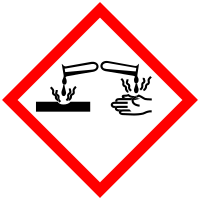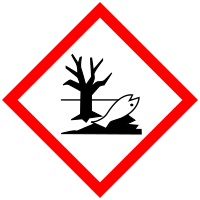
Improving Member States preparedness to face an HNS pollution of the Marine System (HNS-MS)
Ammonium Hydroxide (25%)
Description Top
| CAS number | 1336-21-6 |
| UN number | 2672 |
| Chemical formula | NH5O |
| Accident occurred | Yes |
| Standard European Behaviour Classification (SEBC) | Dissolver that evaporates (DE) |
| Abilities | Solution. |
| Notable risks | Reacts with oxides and peroxides. |
GESAMP Hazard profile
| A1 | A2 | B1 | B2 | C1 | C2 | C3 | D1 | D2 | D3 | E1 | E2 | E3 |
| NI | NI | NI | NI | NI | NI | NI | NI | NI | NI | DE | NI |
Marine pollution Classification (MARPOL Annex II)
| Category | Description |
| Y | Noxious Liquid Substances which, if discharged into the sea from tank cleaning or deballasting operations, are deemed to present a hazard to either marine resources or human health or cause harm to amenities or other legitimate uses of the sea and therefore justify a limitation on the quality and quantity of the discharge into the marine environment. |
Alternate names for this chemical
Ammonia Aqueous
Ammonia Solution
Ammonia Monohydrate
Ammonia Water
Ammonium Monohydrate
Aqua Ammonia
Aqueous Ammonia
Ammonium Hydroxide ((Nh4)(Oh))
Ammonia, Aqueous Solution
Ammoniac Water
Ammonium Hydroxide (25%)
Ammoniaque (25%)
Ammonia Solution
Ammonia Monohydrate
Ammonia Water
Ammonium Monohydrate
Aqua Ammonia
Aqueous Ammonia
Ammonium Hydroxide ((Nh4)(Oh))
Ammonia, Aqueous Solution
Ammoniac Water
Ammonium Hydroxide (25%)
Ammoniaque (25%)
Physico-chemical properties Top
| Chemical formula | NH5O | ||
| Molar mass | 35.05 [g/mol] | ||
| State | Liquid at 25°C and 1 atm | ||
| Fusion temperature | -58 [°C] | ||
| Boiling temperature | 38 [°C] | ||
| Density |
|
||
| Surface tension |
|
||
| Hydrosolubility |
|
||
| Vapour pressure |
|
Behaviour Top
| Log Kow | -0.17 |
| Log Koc | 1.16 |
| Hydrolysis (Half-life) | Not hydrolysable |
| Aqueous photolysis (Half-life) | Not photolysable |
| Biodegradation in estuary environment (Half-life) | 10 days |
| Biodegradation in marine environment (Half-life) | 10 days |
| Standard European Behaviour Classification (SEBC) | Dissolver that evaporates (DE) |
Ecotoxicity Top
| Lowest median lethal concentration (LC50) on algae | 1300 [mg/l] | ||
| Lowest median lethal concentration (LC50) on crustacean | 9 [mg/l] | ||
| Lowest median lethal concentration (LC50) on fishes | 2.4 [mg/l] | ||
| Highest no observed effect concentration (NOEC) on algae | 0.234 [mg/l] | ||
| Highest no observed effect concentration (NOEC) on crustacean | 2 [mg/l] | ||
| Highest no observed effect concentration (NOEC) on fishes | 0.06 [mg/l] | ||
| Assessment factor (AF) |
|
||
| Predicted No Effect Concentration (PNEC) |
|
Hazards Top



Danger
| IDLH | 300 [ppm] |
Hazards statements
Health
H314
Causes severe skin burns and eye damage.
H335
May cause respiratory irritation.
Environmental
H400
Very toxic to aquatic life.
Precautionary statements
Prevention
P260
Do not breathe dust/fume/gas/mist/vapours/spray.
P280
Wear protective gloves/protective clothing/eye protection/face protection.
Response
P391
Collect spillage.
P301 + P330 + P331
IF SWALLOWED: rinse mouth. Do NOT induce vomiting.
P305 + P351 + P338
IF IN EYES: Rinse cautiously with water for several minutes. Remove contact lenses, if present and easy to do. Continue rinsing.
Disposal
P501
Dispose of contents/container to ...
GESAMP Top
GESAMP Hazard profile
| A1 | A2 | B1 | B2 | C1 | C2 | C3 | D1 | D2 | D3 | E1 | E2 | E3 |
| NI | NI | NI | NI | NI | NI | NI | NI | NI | NI | DE | NI |
A1: Bioaccumulation
| Rating | Description |
| NI | No Information |
A1a:
| Rating | Description |
| NI | No Information |
A1b:
| Rating | Description |
| NI | No Information |
A2: Biodegradation
| Rating | Description |
| NI | No Information |
B1: Acute aquatic toxicity
| Rating | Description |
| NI | No Information |
B2: Chronic aquatic toxicity
| Rating | Description |
| NI | No Information |
C1: Acute oral toxicity
| Rating | Description |
| NI | No Information |
C2: Acute dermal toxicity (skin contact)
| Rating | Description |
| NI | No Information |
C3: Acute inhalation toxicity
| Rating | Description |
| NI | No Information |
D1: Skin irritation or corrosion
| Rating | Description |
| NI | No Information |
D2: Eye irritation
| Rating | Description |
| NI | No Information |
D3: Long-term health effects
| Notation | Hazard endpoint | Description | GHS category |
| No Information |
E1: Tainting of seafood
| Rating | Description |
| NI | No Information |
E2: Behaviour of chemicals in the marine environment
| Rating | Description |
| DE | Dissolver that evaporates |
E3: Interference with the use of coastal amenities
| Rating | Description |
| NI | No Information |
GHS Security Information



Danger
About the project
HNS-MS is a decision-support tool that Belgian and French maritime authorities as well as coastguard stations can activate in order to forecast the drift, fate and behavior of acute marine pollution by Harmful Noxious Substances (HNS) accidentally released in the marine system.
Contact us
Copyright © 2015–2026 HNS-MS Consortium
 HNS-MS has been funded by DG-ECHO under agreement ECHO/SUB/2014/693705 and runs from 1 January 2015 to 31 March 2017.
HNS-MS has been funded by DG-ECHO under agreement ECHO/SUB/2014/693705 and runs from 1 January 2015 to 31 March 2017.